Alcohol Culture Impact on Indian Female Post Graduate Students Abroad
VerifiedAdded on 2021/06/17
|7
|1706
|56
Essay
AI Summary
This essay delves into the alcohol culture prevalent among Indian female postgraduate students studying in international universities. It highlights that these students face unique challenges that may contribute to increased alcohol consumption. The introduction provides context by discussing the broader issue of alcohol culture on college campuses and its global impact, noting the specific vulnerabilities of female students. The body of the essay explores several predisposing factors, including stress related to academic pressures, job changes, and separation from family. Peer relationships and social dynamics are also examined, including the influence of peer pressure and the normalization of drinking within the university environment. Furthermore, the essay identifies various social contexts of drinking, such as social facilitation, peer acceptance, and emotional coping, and explains how these contexts shape drinking behaviors. The conclusion emphasizes the need for further research to better understand and address the issue of alcohol use among this specific demographic.
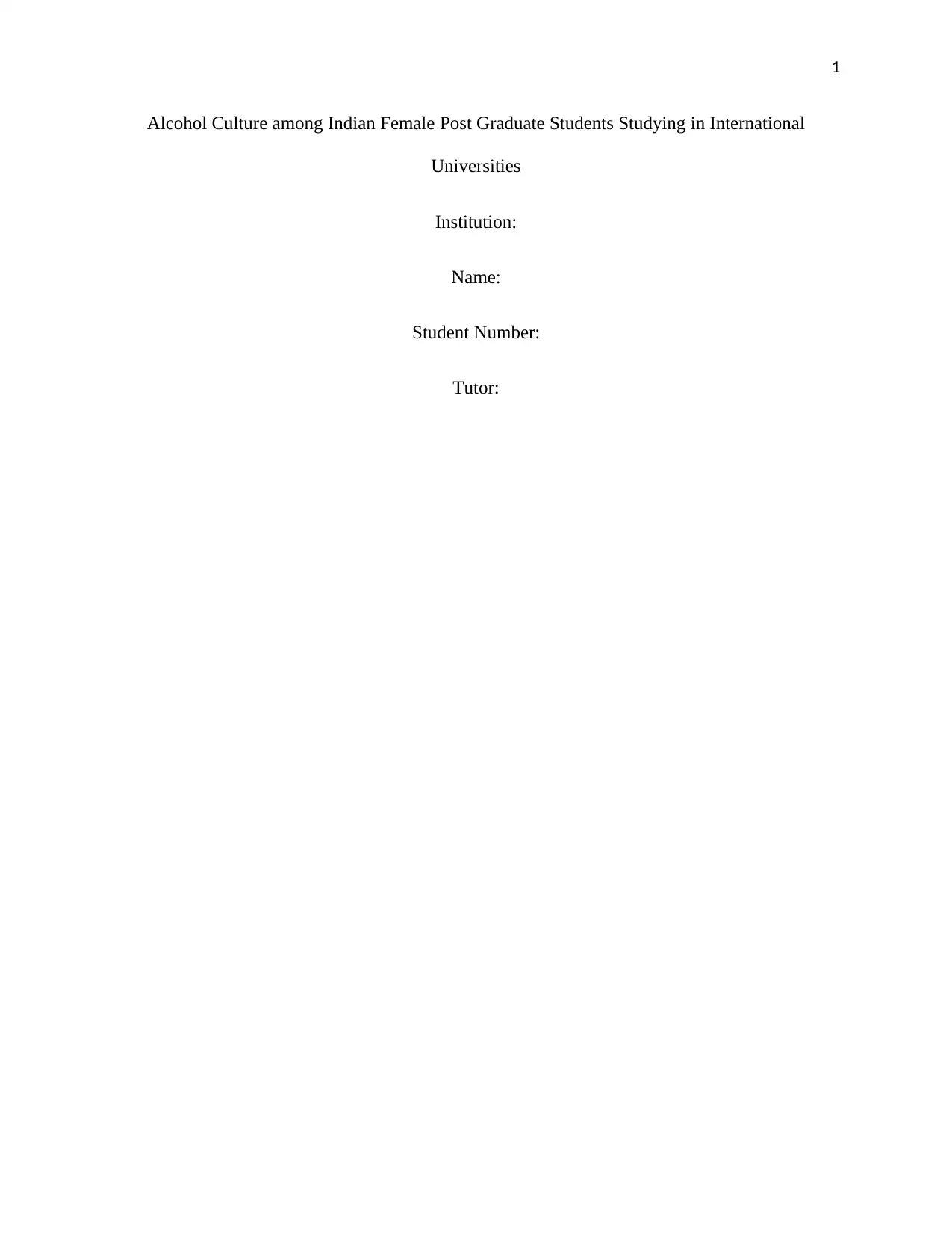
1
Alcohol Culture among Indian Female Post Graduate Students Studying in International
Universities
Institution:
Name:
Student Number:
Tutor:
Alcohol Culture among Indian Female Post Graduate Students Studying in International
Universities
Institution:
Name:
Student Number:
Tutor:
Paraphrase This Document
Need a fresh take? Get an instant paraphrase of this document with our AI Paraphraser
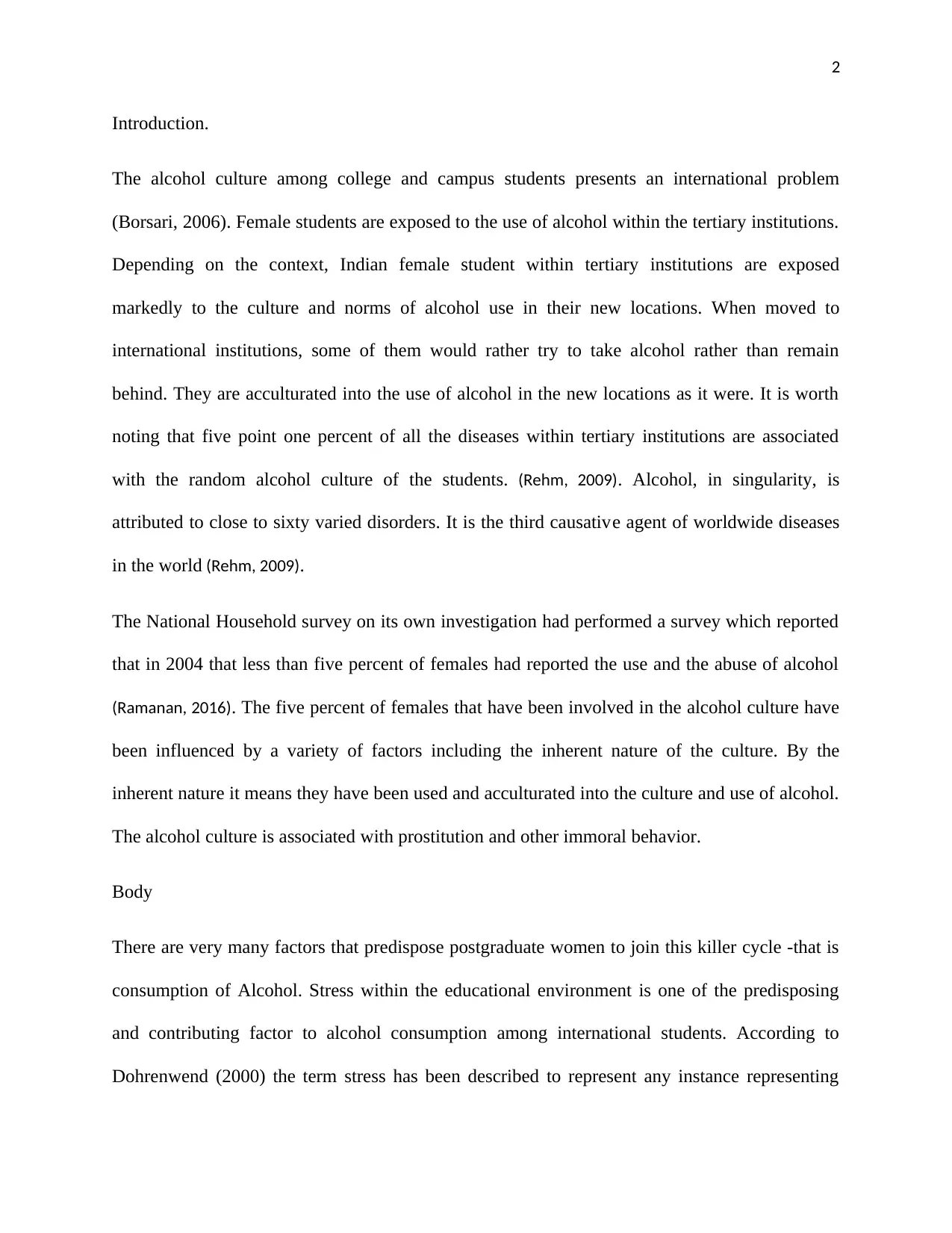
2
Introduction.
The alcohol culture among college and campus students presents an international problem
(Borsari, 2006). Female students are exposed to the use of alcohol within the tertiary institutions.
Depending on the context, Indian female student within tertiary institutions are exposed
markedly to the culture and norms of alcohol use in their new locations. When moved to
international institutions, some of them would rather try to take alcohol rather than remain
behind. They are acculturated into the use of alcohol in the new locations as it were. It is worth
noting that five point one percent of all the diseases within tertiary institutions are associated
with the random alcohol culture of the students. (Rehm, 2009). Alcohol, in singularity, is
attributed to close to sixty varied disorders. It is the third causative agent of worldwide diseases
in the world (Rehm, 2009).
The National Household survey on its own investigation had performed a survey which reported
that in 2004 that less than five percent of females had reported the use and the abuse of alcohol
(Ramanan, 2016). The five percent of females that have been involved in the alcohol culture have
been influenced by a variety of factors including the inherent nature of the culture. By the
inherent nature it means they have been used and acculturated into the culture and use of alcohol.
The alcohol culture is associated with prostitution and other immoral behavior.
Body
There are very many factors that predispose postgraduate women to join this killer cycle -that is
consumption of Alcohol. Stress within the educational environment is one of the predisposing
and contributing factor to alcohol consumption among international students. According to
Dohrenwend (2000) the term stress has been described to represent any instance representing
Introduction.
The alcohol culture among college and campus students presents an international problem
(Borsari, 2006). Female students are exposed to the use of alcohol within the tertiary institutions.
Depending on the context, Indian female student within tertiary institutions are exposed
markedly to the culture and norms of alcohol use in their new locations. When moved to
international institutions, some of them would rather try to take alcohol rather than remain
behind. They are acculturated into the use of alcohol in the new locations as it were. It is worth
noting that five point one percent of all the diseases within tertiary institutions are associated
with the random alcohol culture of the students. (Rehm, 2009). Alcohol, in singularity, is
attributed to close to sixty varied disorders. It is the third causative agent of worldwide diseases
in the world (Rehm, 2009).
The National Household survey on its own investigation had performed a survey which reported
that in 2004 that less than five percent of females had reported the use and the abuse of alcohol
(Ramanan, 2016). The five percent of females that have been involved in the alcohol culture have
been influenced by a variety of factors including the inherent nature of the culture. By the
inherent nature it means they have been used and acculturated into the culture and use of alcohol.
The alcohol culture is associated with prostitution and other immoral behavior.
Body
There are very many factors that predispose postgraduate women to join this killer cycle -that is
consumption of Alcohol. Stress within the educational environment is one of the predisposing
and contributing factor to alcohol consumption among international students. According to
Dohrenwend (2000) the term stress has been described to represent any instance representing
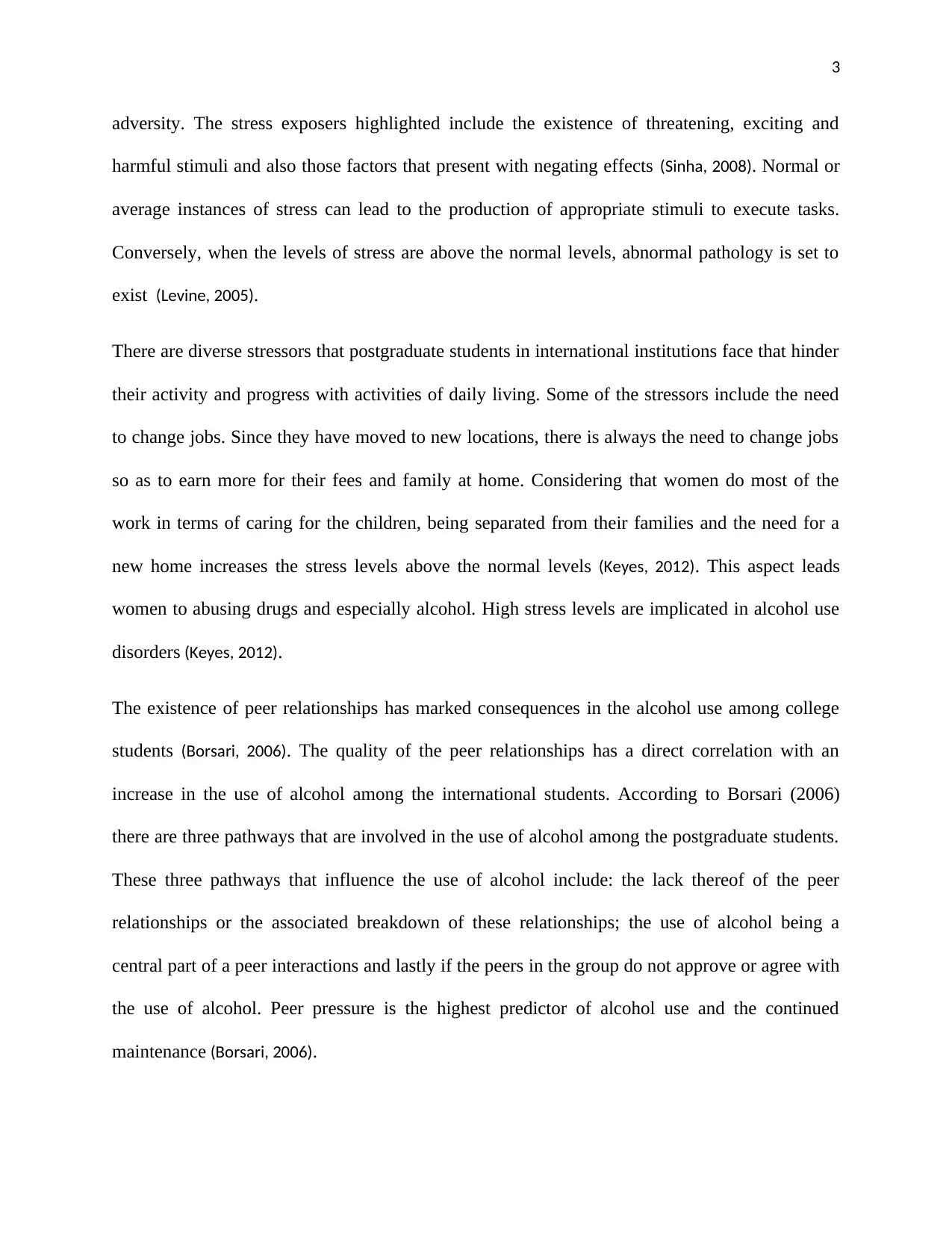
3
adversity. The stress exposers highlighted include the existence of threatening, exciting and
harmful stimuli and also those factors that present with negating effects (Sinha, 2008). Normal or
average instances of stress can lead to the production of appropriate stimuli to execute tasks.
Conversely, when the levels of stress are above the normal levels, abnormal pathology is set to
exist (Levine, 2005).
There are diverse stressors that postgraduate students in international institutions face that hinder
their activity and progress with activities of daily living. Some of the stressors include the need
to change jobs. Since they have moved to new locations, there is always the need to change jobs
so as to earn more for their fees and family at home. Considering that women do most of the
work in terms of caring for the children, being separated from their families and the need for a
new home increases the stress levels above the normal levels (Keyes, 2012). This aspect leads
women to abusing drugs and especially alcohol. High stress levels are implicated in alcohol use
disorders (Keyes, 2012).
The existence of peer relationships has marked consequences in the alcohol use among college
students (Borsari, 2006). The quality of the peer relationships has a direct correlation with an
increase in the use of alcohol among the international students. According to Borsari (2006)
there are three pathways that are involved in the use of alcohol among the postgraduate students.
These three pathways that influence the use of alcohol include: the lack thereof of the peer
relationships or the associated breakdown of these relationships; the use of alcohol being a
central part of a peer interactions and lastly if the peers in the group do not approve or agree with
the use of alcohol. Peer pressure is the highest predictor of alcohol use and the continued
maintenance (Borsari, 2006).
adversity. The stress exposers highlighted include the existence of threatening, exciting and
harmful stimuli and also those factors that present with negating effects (Sinha, 2008). Normal or
average instances of stress can lead to the production of appropriate stimuli to execute tasks.
Conversely, when the levels of stress are above the normal levels, abnormal pathology is set to
exist (Levine, 2005).
There are diverse stressors that postgraduate students in international institutions face that hinder
their activity and progress with activities of daily living. Some of the stressors include the need
to change jobs. Since they have moved to new locations, there is always the need to change jobs
so as to earn more for their fees and family at home. Considering that women do most of the
work in terms of caring for the children, being separated from their families and the need for a
new home increases the stress levels above the normal levels (Keyes, 2012). This aspect leads
women to abusing drugs and especially alcohol. High stress levels are implicated in alcohol use
disorders (Keyes, 2012).
The existence of peer relationships has marked consequences in the alcohol use among college
students (Borsari, 2006). The quality of the peer relationships has a direct correlation with an
increase in the use of alcohol among the international students. According to Borsari (2006)
there are three pathways that are involved in the use of alcohol among the postgraduate students.
These three pathways that influence the use of alcohol include: the lack thereof of the peer
relationships or the associated breakdown of these relationships; the use of alcohol being a
central part of a peer interactions and lastly if the peers in the group do not approve or agree with
the use of alcohol. Peer pressure is the highest predictor of alcohol use and the continued
maintenance (Borsari, 2006).
⊘ This is a preview!⊘
Do you want full access?
Subscribe today to unlock all pages.

Trusted by 1+ million students worldwide
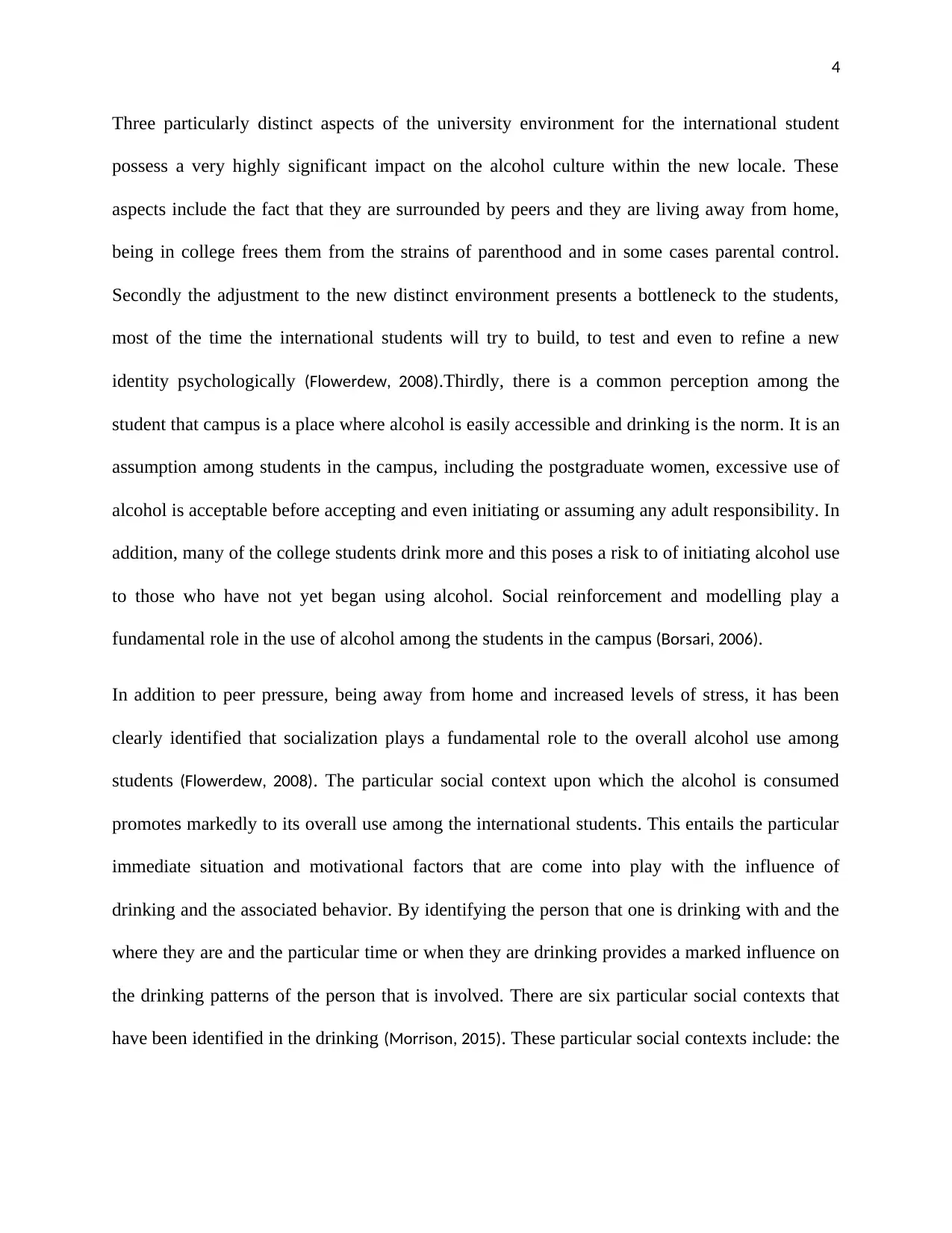
4
Three particularly distinct aspects of the university environment for the international student
possess a very highly significant impact on the alcohol culture within the new locale. These
aspects include the fact that they are surrounded by peers and they are living away from home,
being in college frees them from the strains of parenthood and in some cases parental control.
Secondly the adjustment to the new distinct environment presents a bottleneck to the students,
most of the time the international students will try to build, to test and even to refine a new
identity psychologically (Flowerdew, 2008).Thirdly, there is a common perception among the
student that campus is a place where alcohol is easily accessible and drinking is the norm. It is an
assumption among students in the campus, including the postgraduate women, excessive use of
alcohol is acceptable before accepting and even initiating or assuming any adult responsibility. In
addition, many of the college students drink more and this poses a risk to of initiating alcohol use
to those who have not yet began using alcohol. Social reinforcement and modelling play a
fundamental role in the use of alcohol among the students in the campus (Borsari, 2006).
In addition to peer pressure, being away from home and increased levels of stress, it has been
clearly identified that socialization plays a fundamental role to the overall alcohol use among
students (Flowerdew, 2008). The particular social context upon which the alcohol is consumed
promotes markedly to its overall use among the international students. This entails the particular
immediate situation and motivational factors that are come into play with the influence of
drinking and the associated behavior. By identifying the person that one is drinking with and the
where they are and the particular time or when they are drinking provides a marked influence on
the drinking patterns of the person that is involved. There are six particular social contexts that
have been identified in the drinking (Morrison, 2015). These particular social contexts include: the
Three particularly distinct aspects of the university environment for the international student
possess a very highly significant impact on the alcohol culture within the new locale. These
aspects include the fact that they are surrounded by peers and they are living away from home,
being in college frees them from the strains of parenthood and in some cases parental control.
Secondly the adjustment to the new distinct environment presents a bottleneck to the students,
most of the time the international students will try to build, to test and even to refine a new
identity psychologically (Flowerdew, 2008).Thirdly, there is a common perception among the
student that campus is a place where alcohol is easily accessible and drinking is the norm. It is an
assumption among students in the campus, including the postgraduate women, excessive use of
alcohol is acceptable before accepting and even initiating or assuming any adult responsibility. In
addition, many of the college students drink more and this poses a risk to of initiating alcohol use
to those who have not yet began using alcohol. Social reinforcement and modelling play a
fundamental role in the use of alcohol among the students in the campus (Borsari, 2006).
In addition to peer pressure, being away from home and increased levels of stress, it has been
clearly identified that socialization plays a fundamental role to the overall alcohol use among
students (Flowerdew, 2008). The particular social context upon which the alcohol is consumed
promotes markedly to its overall use among the international students. This entails the particular
immediate situation and motivational factors that are come into play with the influence of
drinking and the associated behavior. By identifying the person that one is drinking with and the
where they are and the particular time or when they are drinking provides a marked influence on
the drinking patterns of the person that is involved. There are six particular social contexts that
have been identified in the drinking (Morrison, 2015). These particular social contexts include: the
Paraphrase This Document
Need a fresh take? Get an instant paraphrase of this document with our AI Paraphraser
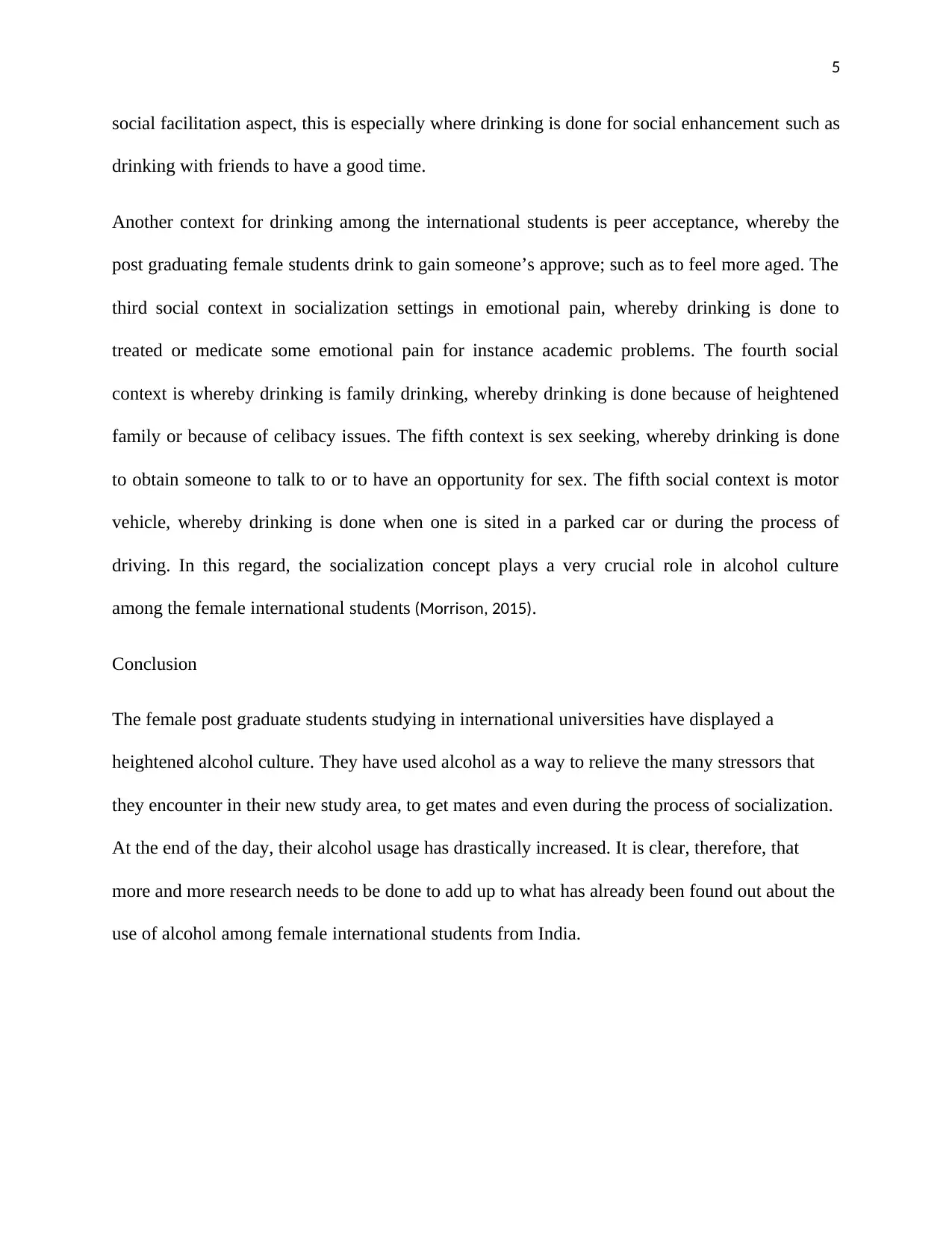
5
social facilitation aspect, this is especially where drinking is done for social enhancement such as
drinking with friends to have a good time.
Another context for drinking among the international students is peer acceptance, whereby the
post graduating female students drink to gain someone’s approve; such as to feel more aged. The
third social context in socialization settings in emotional pain, whereby drinking is done to
treated or medicate some emotional pain for instance academic problems. The fourth social
context is whereby drinking is family drinking, whereby drinking is done because of heightened
family or because of celibacy issues. The fifth context is sex seeking, whereby drinking is done
to obtain someone to talk to or to have an opportunity for sex. The fifth social context is motor
vehicle, whereby drinking is done when one is sited in a parked car or during the process of
driving. In this regard, the socialization concept plays a very crucial role in alcohol culture
among the female international students (Morrison, 2015).
Conclusion
The female post graduate students studying in international universities have displayed a
heightened alcohol culture. They have used alcohol as a way to relieve the many stressors that
they encounter in their new study area, to get mates and even during the process of socialization.
At the end of the day, their alcohol usage has drastically increased. It is clear, therefore, that
more and more research needs to be done to add up to what has already been found out about the
use of alcohol among female international students from India.
social facilitation aspect, this is especially where drinking is done for social enhancement such as
drinking with friends to have a good time.
Another context for drinking among the international students is peer acceptance, whereby the
post graduating female students drink to gain someone’s approve; such as to feel more aged. The
third social context in socialization settings in emotional pain, whereby drinking is done to
treated or medicate some emotional pain for instance academic problems. The fourth social
context is whereby drinking is family drinking, whereby drinking is done because of heightened
family or because of celibacy issues. The fifth context is sex seeking, whereby drinking is done
to obtain someone to talk to or to have an opportunity for sex. The fifth social context is motor
vehicle, whereby drinking is done when one is sited in a parked car or during the process of
driving. In this regard, the socialization concept plays a very crucial role in alcohol culture
among the female international students (Morrison, 2015).
Conclusion
The female post graduate students studying in international universities have displayed a
heightened alcohol culture. They have used alcohol as a way to relieve the many stressors that
they encounter in their new study area, to get mates and even during the process of socialization.
At the end of the day, their alcohol usage has drastically increased. It is clear, therefore, that
more and more research needs to be done to add up to what has already been found out about the
use of alcohol among female international students from India.
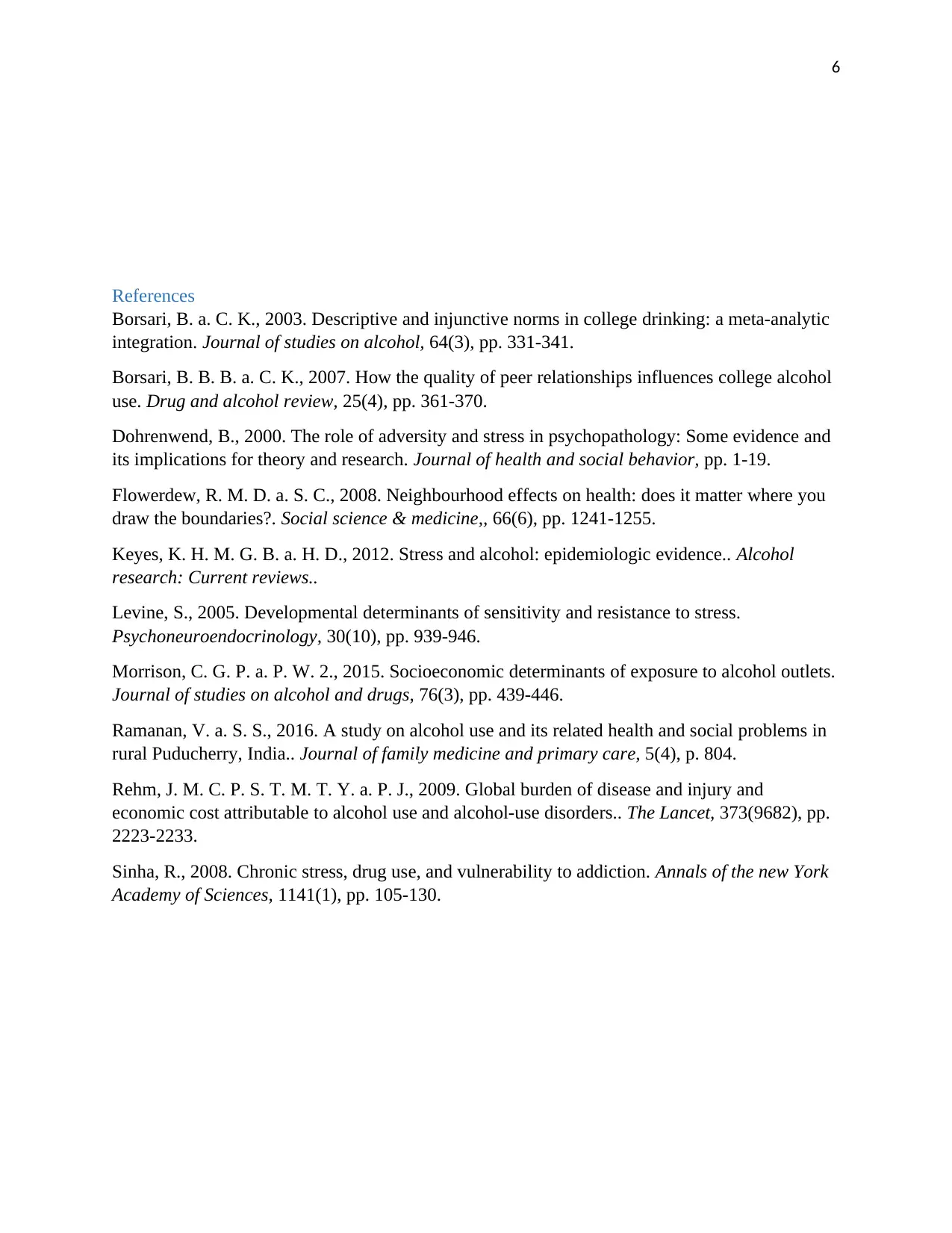
6
References
Borsari, B. a. C. K., 2003. Descriptive and injunctive norms in college drinking: a meta-analytic
integration. Journal of studies on alcohol, 64(3), pp. 331-341.
Borsari, B. B. B. a. C. K., 2007. How the quality of peer relationships influences college alcohol
use. Drug and alcohol review, 25(4), pp. 361-370.
Dohrenwend, B., 2000. The role of adversity and stress in psychopathology: Some evidence and
its implications for theory and research. Journal of health and social behavior, pp. 1-19.
Flowerdew, R. M. D. a. S. C., 2008. Neighbourhood effects on health: does it matter where you
draw the boundaries?. Social science & medicine,, 66(6), pp. 1241-1255.
Keyes, K. H. M. G. B. a. H. D., 2012. Stress and alcohol: epidemiologic evidence.. Alcohol
research: Current reviews..
Levine, S., 2005. Developmental determinants of sensitivity and resistance to stress.
Psychoneuroendocrinology, 30(10), pp. 939-946.
Morrison, C. G. P. a. P. W. 2., 2015. Socioeconomic determinants of exposure to alcohol outlets.
Journal of studies on alcohol and drugs, 76(3), pp. 439-446.
Ramanan, V. a. S. S., 2016. A study on alcohol use and its related health and social problems in
rural Puducherry, India.. Journal of family medicine and primary care, 5(4), p. 804.
Rehm, J. M. C. P. S. T. M. T. Y. a. P. J., 2009. Global burden of disease and injury and
economic cost attributable to alcohol use and alcohol-use disorders.. The Lancet, 373(9682), pp.
2223-2233.
Sinha, R., 2008. Chronic stress, drug use, and vulnerability to addiction. Annals of the new York
Academy of Sciences, 1141(1), pp. 105-130.
References
Borsari, B. a. C. K., 2003. Descriptive and injunctive norms in college drinking: a meta-analytic
integration. Journal of studies on alcohol, 64(3), pp. 331-341.
Borsari, B. B. B. a. C. K., 2007. How the quality of peer relationships influences college alcohol
use. Drug and alcohol review, 25(4), pp. 361-370.
Dohrenwend, B., 2000. The role of adversity and stress in psychopathology: Some evidence and
its implications for theory and research. Journal of health and social behavior, pp. 1-19.
Flowerdew, R. M. D. a. S. C., 2008. Neighbourhood effects on health: does it matter where you
draw the boundaries?. Social science & medicine,, 66(6), pp. 1241-1255.
Keyes, K. H. M. G. B. a. H. D., 2012. Stress and alcohol: epidemiologic evidence.. Alcohol
research: Current reviews..
Levine, S., 2005. Developmental determinants of sensitivity and resistance to stress.
Psychoneuroendocrinology, 30(10), pp. 939-946.
Morrison, C. G. P. a. P. W. 2., 2015. Socioeconomic determinants of exposure to alcohol outlets.
Journal of studies on alcohol and drugs, 76(3), pp. 439-446.
Ramanan, V. a. S. S., 2016. A study on alcohol use and its related health and social problems in
rural Puducherry, India.. Journal of family medicine and primary care, 5(4), p. 804.
Rehm, J. M. C. P. S. T. M. T. Y. a. P. J., 2009. Global burden of disease and injury and
economic cost attributable to alcohol use and alcohol-use disorders.. The Lancet, 373(9682), pp.
2223-2233.
Sinha, R., 2008. Chronic stress, drug use, and vulnerability to addiction. Annals of the new York
Academy of Sciences, 1141(1), pp. 105-130.
⊘ This is a preview!⊘
Do you want full access?
Subscribe today to unlock all pages.

Trusted by 1+ million students worldwide

7
1 out of 7
Your All-in-One AI-Powered Toolkit for Academic Success.
+13062052269
info@desklib.com
Available 24*7 on WhatsApp / Email
![[object Object]](/_next/static/media/star-bottom.7253800d.svg)
Unlock your academic potential
Copyright © 2020–2025 A2Z Services. All Rights Reserved. Developed and managed by ZUCOL.